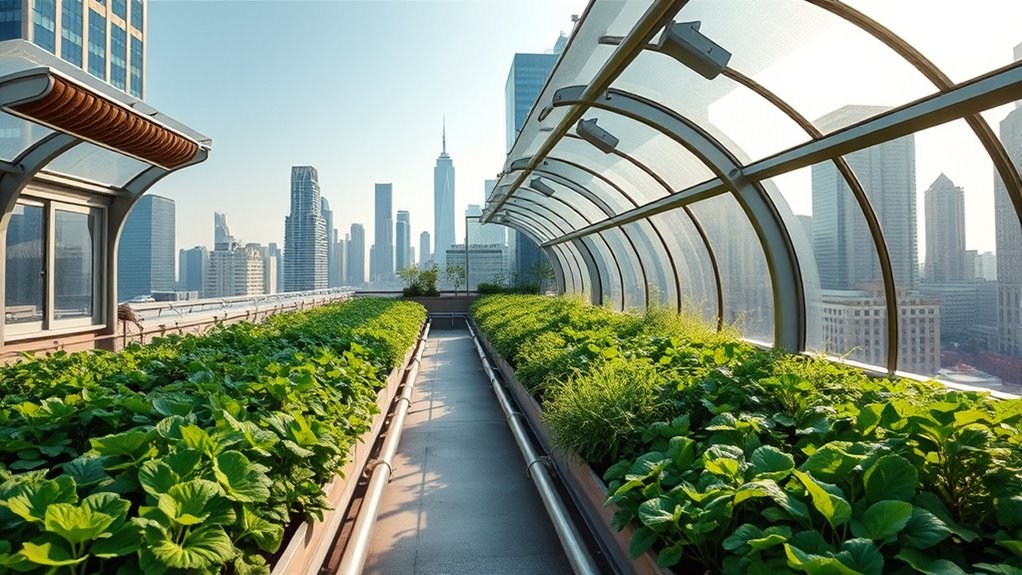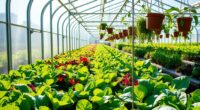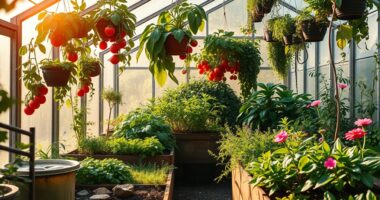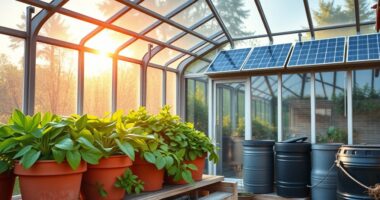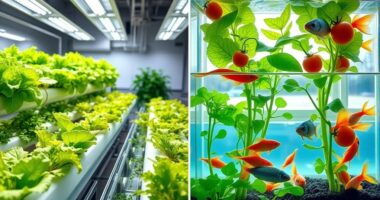Greenhouses are essential for urban farming because they create controlled environments that extend growing seasons, boost crop diversity, and improve yields year-round. They help you optimize resources like water and energy, while reducing pests and weather-related risks. Greenhouses also support sustainable practices and community health by providing fresh, local produce. If you’re curious about how they transform city landscapes and enhance food security, there’s plenty more to explore.
Key Takeaways
- Greenhouses extend growing seasons and increase crop yields in urban environments.
- They create controlled environments for diverse crops, supporting year-round farming and pest management.
- Greenhouses enhance urban biodiversity and aesthetics by transforming rooftops and vacant lots into green spaces.
- They promote sustainable practices through resource optimization like solar energy and water recycling.
- Greenhouses help improve local food security and community engagement by providing fresh, nutritious produce.
Benefits of Greenhouses for City Agriculture
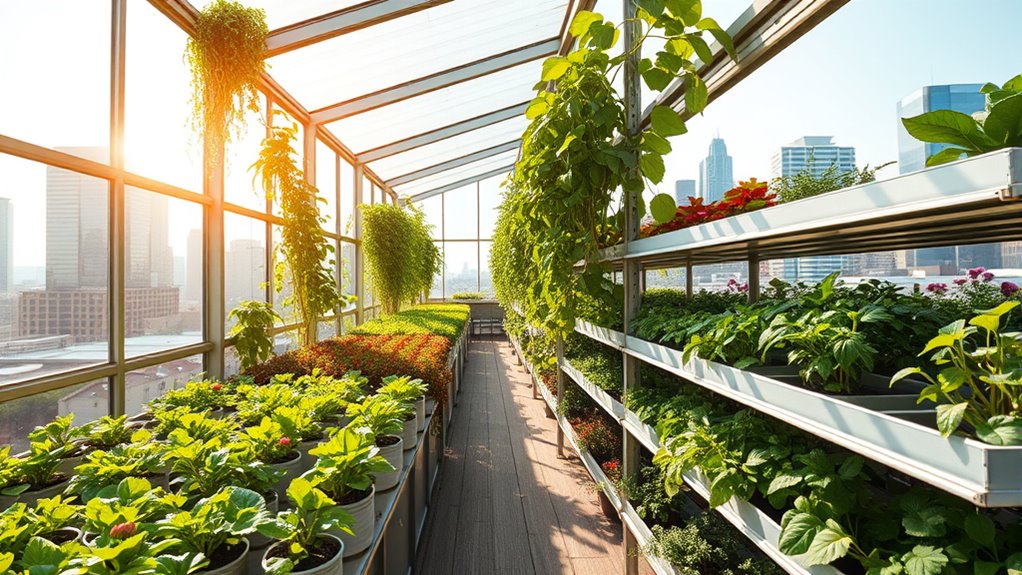
Greenhouses offer several key advantages for city agriculture by creating controlled environments that extend growing seasons and improve crop yields. They also promote urban biodiversity by providing habitats for various plants, insects, and birds, enriching the local ecosystem. Additionally, greenhouses enhance aesthetics in urban settings, transforming dull rooftops or vacant lots into vibrant, green spaces that attract community interest. This visual appeal encourages sustainable practices and fosters a connection between residents and their environment. Incorporating proper comfort solutions such as climate control systems can further optimize plant growth conditions within greenhouses.
Types of Greenhouses Used in Urban Settings
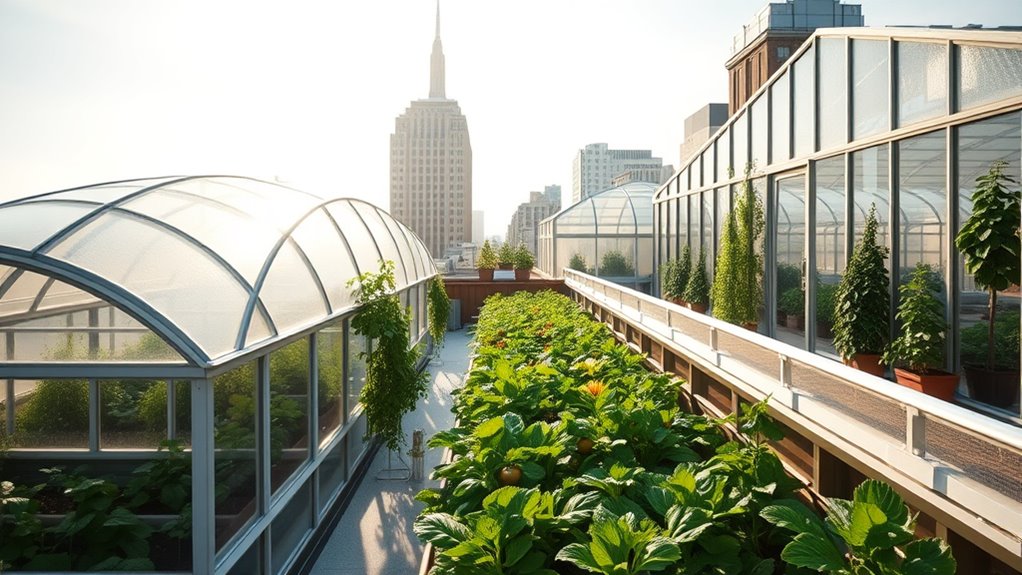
When choosing greenhouses for urban farming, you’ll encounter traditional glass options that offer excellent light transmission and durability. Alternatively, polycarbonate modular structures provide flexibility and insulation, making them ideal for compact city spaces. Understanding these types helps you select the best fit for your farming goals and available space. Incorporating high-quality materials can further enhance the longevity and efficiency of your greenhouse setup.
Traditional Glass Greenhouses
Have you ever wondered why traditional glass greenhouses remain a popular choice for urban farming? Their clear glass panels let in maximum sunlight, essential for healthy plant growth. Many urban farmers complement these greenhouses with solar panels to generate clean energy, reducing operational costs. Unique and Wicked Planters are often used inside to enhance the aesthetic appeal and optimize space utilization. The transparency also makes pest control easier, as you can quickly spot issues and address them without invasive measures. Natural materials, such as wood and stone, contribute to the eco-friendly aspect of these greenhouses and support sustainable practices. Additionally, the use of regional flavors and traditions in design and plant selection can enhance the cultural connection within urban farming settings. While glass greenhouses are durable and provide excellent insulation, they require regular maintenance to keep the glass clean and intact. Incorporating automation technology can further improve efficiency by monitoring environmental conditions and adjusting parameters automatically. The traditional design suits a variety of crops and allows for customization, making it a versatile option. It is also worth noting that climate control techniques are often integrated to optimize growth conditions regardless of external weather. Overall, their proven efficiency and eco-friendly features make glass greenhouses a staple in urban farming environments.
Polycarbonate Modular Structures
Polycarbonate modular structures have become a popular choice for urban farming because of their lightweight, durable, and versatile design. Their polycarbonate durability means they can withstand weather fluctuations, making them ideal for city environments. Embracing a lifestyle of kindness and compassion in urban farming encourages community building and sustainable practices. The modular design allows you to customize and expand your greenhouse easily, fitting various space sizes and configurations. These structures are quick to assemble, saving you time and effort, while their lightweight nature makes relocation simple if needed. Plus, the high impact resistance of polycarbonate panels ensures your crops stay protected from hail, wind, and other elements. Additionally, the use of cookies and data tracking in website management helps improve user experience and optimize the functionality of online resources. Incorporating energy-efficient materials can further enhance the sustainability of these greenhouses, reducing environmental impact and operational costs. Furthermore, selecting weather-resistant materials can extend the lifespan of your greenhouse in challenging urban climates. Leveraging AI-powered content clusters allows for targeted content optimization that can support your urban farming knowledge base and outreach efforts. Overall, polycarbonate modular greenhouses provide a practical, resilient, and adaptable solution that supports year-round urban farming efforts efficiently.
Extending Growing Seasons With Controlled Environments
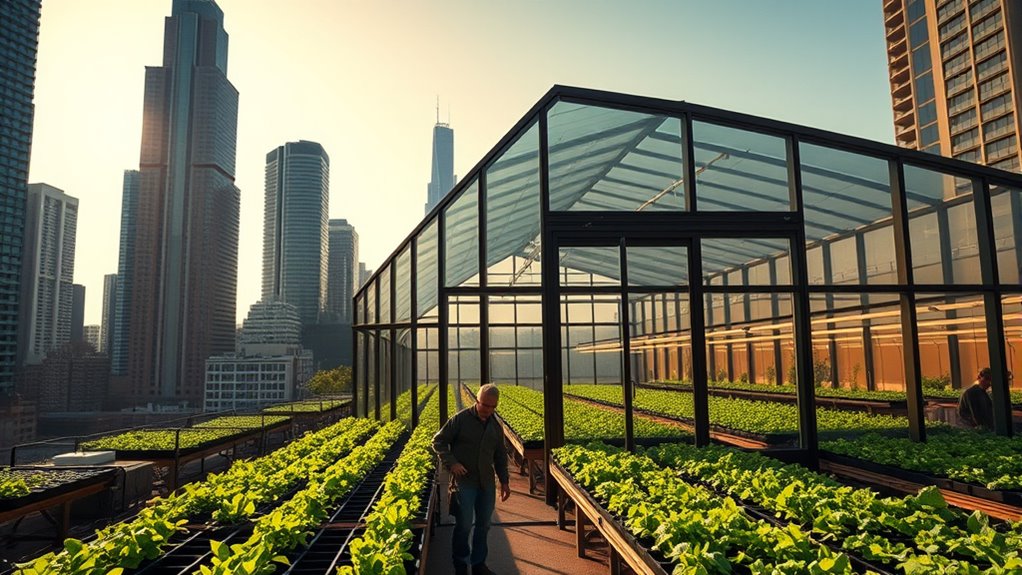
Controlled environments in greenhouses allow urban farmers to extend their growing seasons beyond outdoor limitations. By regulating temperature, humidity, and light, you can create ideal conditions for crops year-round. Climate regulation helps you avoid frost and extreme weather, ensuring consistent growth. Additionally, controlled environments simplify pest management, reducing the need for chemical treatments and protecting your harvest. With precise control over environmental factors, you can grow a wider variety of crops outside their typical seasons, increasing your farm’s productivity. This flexibility allows you to meet local demand and maximize space efficiency. Incorporating advanced climate control systems can further optimize growing conditions and improve overall yields.
Enhancing Crop Diversity in Urban Farms
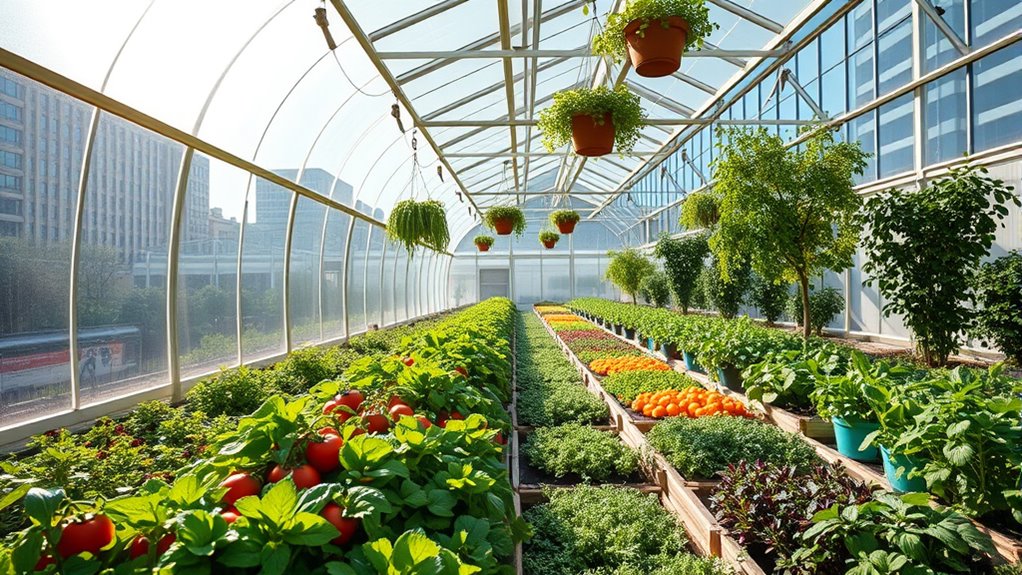
By expanding your crop choices, you can increase the variety grown in urban farms and reduce reliance on a few staples.
Greenhouses make it easier to support exotic crops that wouldn’t survive outdoors, adding unique flavors and nutritional options.
This approach helps create a more resilient and diverse urban farming system.
Extending Growing Seasons
Extending growing seasons in urban farms allows you to produce crops beyond their typical outdoor timelines, increasing overall productivity and crop diversity. Greenhouses create a controlled environment that shields plants from harsh weather, enabling you to grow crops year-round. This extended period helps you implement pest management strategies more effectively, reducing the need for chemical interventions and promoting healthier plants. Additionally, soil sterilization within greenhouses minimizes soil-borne diseases and pests, ensuring a clean foundation for new planting cycles. Greenhouses also allow for climate control, which can optimize conditions for a wider variety of crops and improve yields throughout the year. Proper ventilation inside the greenhouse is essential for regulating temperature and humidity, further supporting healthy plant growth. Maintaining proper storage of tools and supplies inside the greenhouse further enhances efficiency and crop health.
Supporting Exotic Crops
Have you considered adding exotic crops to your urban farm? Greenhouses make it possible to grow tropical fruit cultivation that wouldn’t survive outdoors. With controlled temperatures and humidity, you can cultivate mangoes, lychees, or passion fruit year-round. Utilizing best greenhouse equipment can optimize conditions for these delicate plants. Supporting exotic crops also includes exotic flower propagation, allowing you to grow vibrant, rare flowers that attract pollinators and add aesthetic value. Greenhouses provide an ideal environment for these delicate plants, reducing pests and disease risks. Incorporating climate control systems ensures precise regulation of environmental factors, further enhancing plant health and yield. By diversifying your crop selection with these exotic options, you enhance your farm’s uniqueness and market appeal. Plus, cultivating such crops can open new revenue streams.
Increasing Plant Variety
Enhancing crop diversity is essential for creating a resilient and productive urban farm. By increasing plant variety, you reduce the risk of pests and disease outbreaks, strengthening crop resilience. Incorporating skincare patches into your pest management strategies can serve as a metaphor for targeted, effective intervention, highlighting the importance of precise applications. Plant breeding plays a key role here, allowing you to develop new varieties better adapted to your greenhouse conditions. This not only broadens your options but also improves pest management by introducing crops with natural resistance. Diversifying your plant selection also attracts beneficial insects, reducing the need for chemical controls. With a wider array of crops, you can extend harvest seasons and meet varied consumer demands, increasing your farm’s profitability.
Resource Optimization and Sustainability Strategies
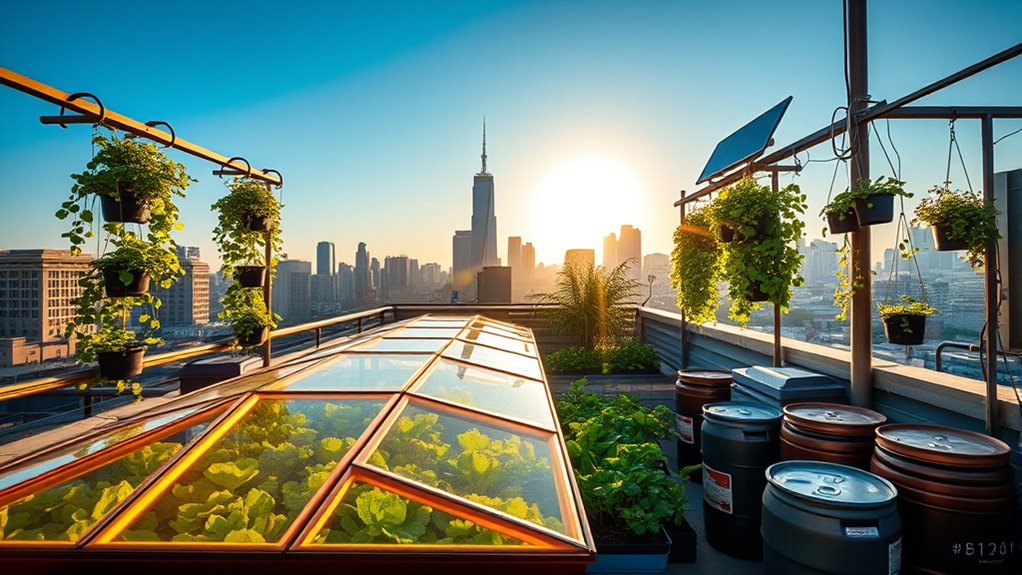
To make urban greenhouses more sustainable, optimizing resource use is essential. Solar integration plays a key role by harnessing sunlight to reduce energy consumption and lower costs. Installing solar panels allows you to generate clean energy, decreasing reliance on fossil fuels and minimizing your carbon footprint. Proper storage techniques for harvested rainwater can further enhance water efficiency. Effective pest management is also critical; using integrated pest management techniques reduces the need for chemical pesticides, promoting healthier plants and a safer environment. You can implement biological controls and monitor pests regularly to prevent outbreaks. Additionally, water conservation methods like rainwater harvesting and drip irrigation help maximize resource efficiency.
Innovative Technologies in Urban Greenhouse Farming

Innovative technologies like automated climate control and smart water management are transforming urban greenhouse farming.
These systems help you maintain ideal conditions and conserve resources efficiently.
Embracing such tools can boost your productivity while supporting sustainability efforts.
Automated Climate Control
Automated climate control systems are transforming urban greenhouse farming by precisely managing temperature, humidity, and airflow. You can rely on climate sensors to monitor environmental conditions in real-time, ensuring ideal growth. These sensors feed data into automated systems that adjust fans, heaters, and vents instantly. Additionally, automated watering works seamlessly with climate controls, maintaining consistent moisture levels without manual effort. This integration prevents overwatering or drought stress, boosting plant health. Here’s a quick overview:
| Feature | Function | Benefit |
|---|---|---|
| Climate sensors | Detect temperature, humidity, airflow | Precise environmental regulation |
| Automated watering | Adjusts watering based on soil/moisture data | Consistent moisture, saves water |
| Airflow management | Opens/closes vents to control airflow | Prevents mold, promotes growth |
This technology enhances efficiency and crop quality, making urban greenhouse farming more sustainable.
Smart Water Management
Have you ever wondered how urban greenhouses optimize water use while ensuring healthy plant growth? Smart water management is key, and technologies like drip irrigation play a crucial role. Drip systems deliver water directly to the plant roots, reducing waste and evaporation. This precise watering method helps conserve water and promotes efficient nutrient management, ensuring plants receive the right nutrients at the right time.
Sensors monitor soil moisture levels continuously, allowing you to adjust watering schedules automatically. This integration minimizes overwatering and underwatering, leading to healthier crops and lower water bills.
Challenges Faced by Urban Greenhouse Installations
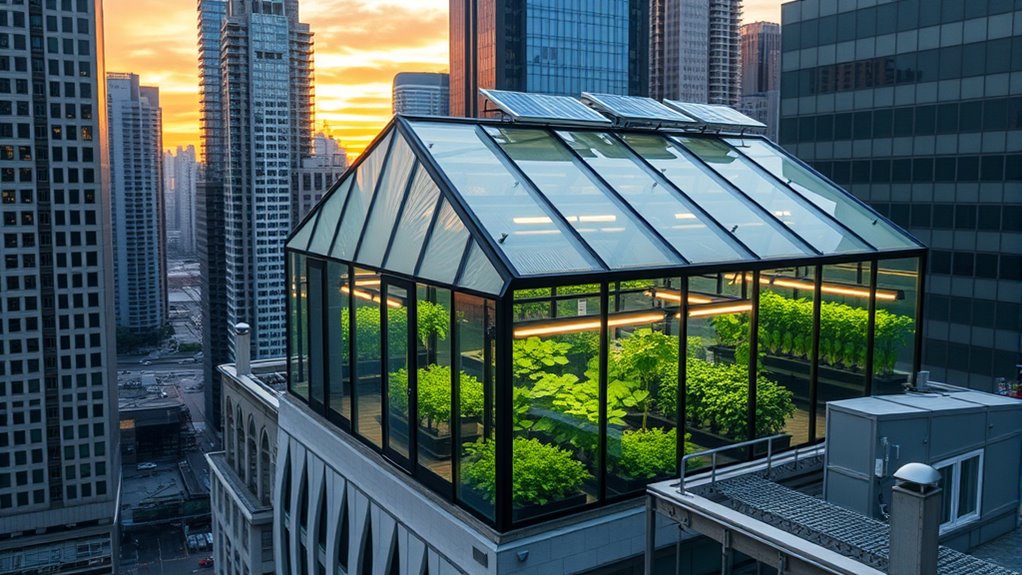
Urban greenhouse installations often face significant hurdles, including limited space, high setup costs, and regulatory restrictions. Urban zoning laws can complicate approvals, delaying or blocking new projects. You might also encounter restrictions on building height or land use, limiting design options.
Additionally, air circulation proves critical in small urban settings; poor airflow can lead to humidity buildup, mold, and plant health issues. Ensuring proper ventilation requires careful planning and investment, which can increase costs.
You may need to work closely with city officials to navigate zoning rules and obtain permits. Balancing these challenges, especially in densely populated areas, demands innovation and strategic planning to optimize space, meet regulations, and maintain healthy air circulation for successful greenhouse operations.
Case Studies of Successful Urban Greenhouse Projects
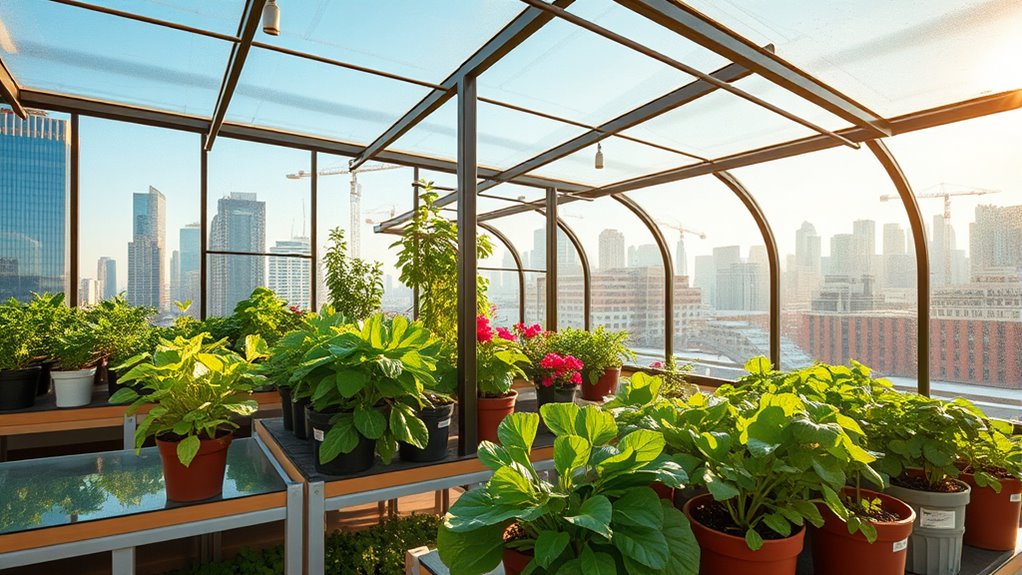
Despite the challenges faced by city-based greenhouses, several projects have successfully transformed urban spaces into productive agricultural hubs. Rooftop conversions stand out as prime examples, turning underused rooftops into vibrant farms that supply fresh produce locally.
For instance, some cities have seen community-led initiatives turn abandoned or vacant rooftops into thriving greenhouses, fostering local food production and community engagement. These projects often involve residents directly in planning and maintenance, ensuring sustainability and long-term success.
Future Trends in Greenhouse-Based Urban Agriculture
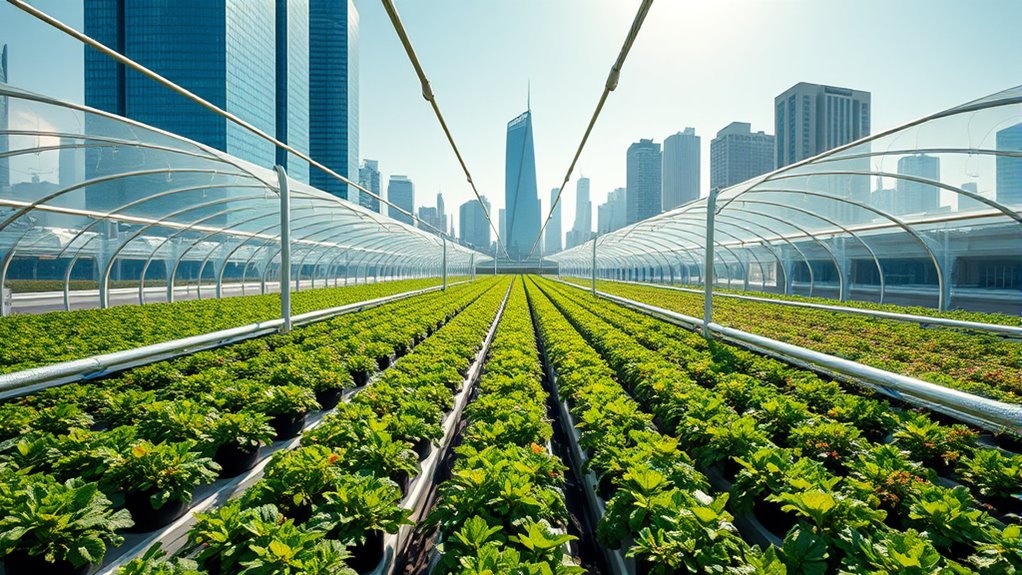
As greenhouses in cities continue to prove their value through successful projects, innovations are shaping their future potential. Vertical farming within greenhouses is gaining momentum, allowing you to maximize space and grow more food vertically. This approach reduces land use and improves efficiency, making urban farming more sustainable.
Additionally, integrating renewable energy sources like solar panels and wind turbines into greenhouse operations will lower energy costs and decrease environmental impact. These technologies enable you to operate greenhouses with minimal reliance on fossil fuels, promoting eco-friendly practices.
Going forward, you’ll see smarter, energy-efficient systems that optimize resource use and boost productivity. These trends will make greenhouse-based urban agriculture more resilient, scalable, and sustainable, ensuring it plays a crucial role in future city food systems.
How Greenhouses Contribute to Local Food Security
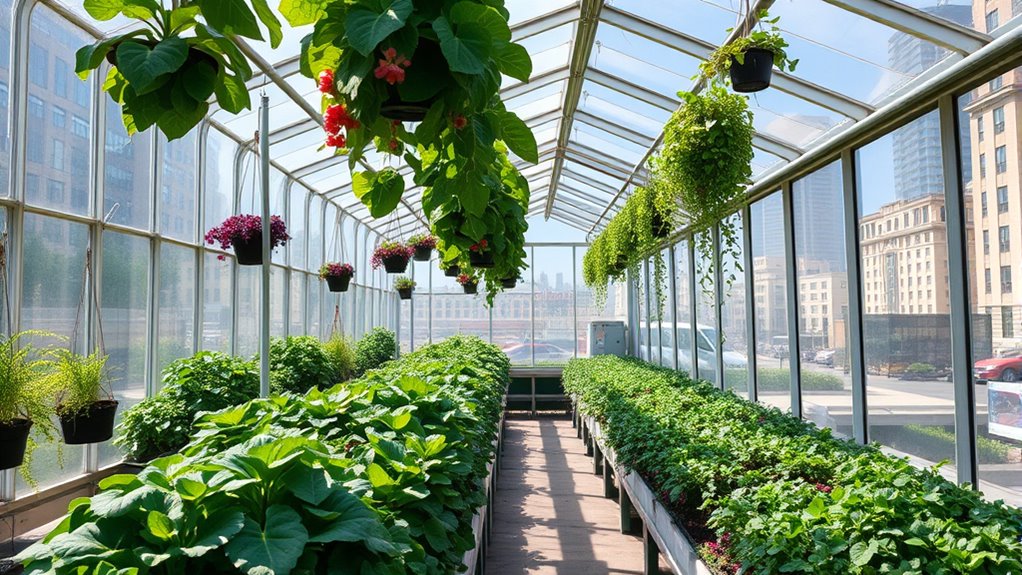
Greenhouses play a crucial role in strengthening local food security by enabling year-round production of fresh produce close to where people live. They reduce dependency on external food sources and help buffer against supply chain disruptions.
Inside a greenhouse, you can implement effective pest management strategies, minimizing crop loss and reducing the need for chemical pesticides. This controlled environment also enhances soil fertility, allowing you to optimize nutrient levels and promote healthy plant growth.
By maintaining consistent growing conditions, greenhouses ensure a steady supply of vegetables and herbs, even during harsh weather. This reliability supports local communities by providing access to fresh, nutritious food regularly.
Frequently Asked Questions
How Do Greenhouses Impact Urban Heat Island Effects?
Greenhouses can help mitigate urban heat by providing shaded, cooler environments that reduce local urban heat effects. They absorb less heat than concrete or asphalt, which typically intensify urban heat islands.
By incorporating greenhouses into cityscapes, you actively contribute to climate mitigation, lowering overall urban heat and creating more comfortable, sustainable environments.
Their presence supports temperature regulation and promotes greener, more resilient urban spaces.
What Are the Initial Costs of Establishing a City Greenhouse?
Did you know that establishing a city greenhouse can cost between $50,000 and $250,000? You’ll need to think about the cost estimation for land, materials, and equipment.
These investment challenges include securing funding and handling permits. The initial costs might seem high, but they can pay off with fresh produce and sustainability benefits.
Planning carefully helps you manage expenses and set realistic expectations for your urban farming project.
How Do Greenhouses Influence Local Biodiversity and Ecosystems?
Greenhouses can positively influence local biodiversity by providing habitats for native pollinators, helping them thrive amid urbanization. They also act as barriers against invasive species, preventing their spread into surrounding ecosystems.
What Funding Options Are Available for Urban Greenhouse Projects?
Did you know that over 60% of urban greenhouse projects get funding through diverse sources? You can explore grant opportunities from government agencies, environmental organizations, and private foundations to support your project.
Public-private partnerships also offer a viable option, combining resources and expertise from local governments and private investors. These funding options help you turn your urban greenhouse idea into reality, fostering sustainable city farming initiatives and community resilience.
How Can Greenhouses Be Integrated Into Existing City Infrastructure?
You can integrate greenhouses into existing city infrastructure by transforming rooftops into vertical farms or rooftop gardens. This approach maximizes space and promotes sustainable food production within urban areas.
By installing greenhouses on building rooftops, you leverage unused space, improve air quality, and create local food sources.
Incorporating vertical farming techniques allows you to grow crops efficiently in limited spaces, making urban environments more self-sufficient and environmentally friendly.
Conclusion
Greenhouses transform city farming, offering year-round growth and diverse crops. While they boost local food security and sustainability, challenges like high costs and space constraints remain. Yet, their potential for innovation and community resilience stands out. As urban greenhouses flourish, they remind us that progress often balances opportunity with obstacle—each greenhouse a proof to how urban agriculture can thrive amid adversity, shaping a greener, more self-sufficient cityscape.
